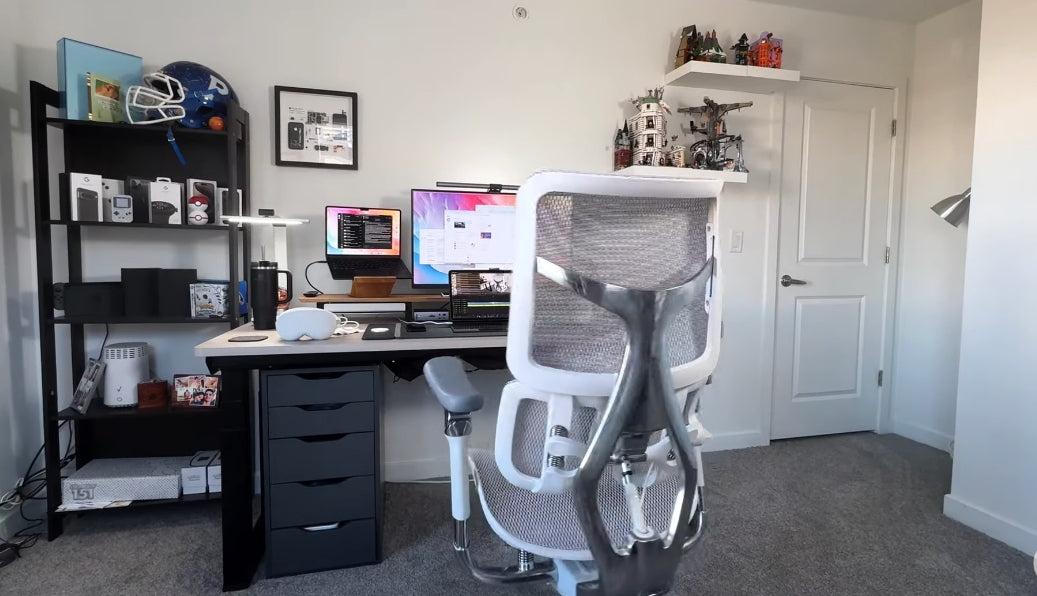While this sedentary lifestyle is unavoidable for many, it often leads to discomfort and pain, particularly in the legs. This blog post will delve into how to sit correctly in an office chair to prevent leg pain, offering practical tips and insights to ensure a comfortable and pain-free experience.
Understanding the Causes of Leg Pain
Before diving into the solutions, it’s important to understand the common causes of leg pain associated with prolonged sitting. Some of the key factors include:
- Poor Posture: Slouching or sitting improperly can lead to muscle strain and decreased circulation, causing pain and discomfort.
- Inadequate Chair Support: An office chair that doesn’t provide proper lumbar support or is not adjustable can contribute to poor posture and leg pain.
- Extended Sitting: Sitting for long periods can reduce blood flow to the legs, leading to swelling, stiffness, and pain.
- Incorrect Chair Height: If your chair is too high or too low, it can cause your legs to be improperly positioned, leading to discomfort.
Tips for Preventing Leg Pain
1. Choose the Right Chair
Investing in a high-quality ergonomic chair is crucial. Look for chairs that offer:
- Adjustable Height: Ensure the chair height can be adjusted so your feet rest flat on the floor, with your knees at a 90-degree angle.
- Lumbar Support: Proper lumbar support helps maintain the natural curve of your spine, reducing strain on your lower back and legs.
- Seat Depth: The seat should be deep enough to support your thighs without pressing against the back of your knees. Ideally, there should be about 2-3 inches of space between the edge of the seat and the back of your knees.
2. Adjust Your Sitting Position
Proper sitting posture is essential in preventing leg pain. Follow these steps to ensure you're sitting correctly:
- Feet Flat on the Floor: Your feet should be flat on the floor or on a footrest, with your knees bent at a 90-degree angle.
- Avoid Crossing Your Legs: Crossing your legs can restrict blood flow and lead to discomfort. Instead, keep your feet flat and your legs uncrossed.
- Sit Back in Your Chair: Sit back in your chair so your back is fully supported by the backrest. This helps maintain good posture and reduces strain on your legs.
- Use a Footrest if Needed: If your feet don’t reach the floor comfortably, use a footrest to ensure your legs are properly supported.
3. Take Regular Breaks
Even with the best chair and posture, sitting for long periods can still lead to leg pain. Make it a habit to take regular breaks:
- Stand Up and Stretch: Stand up and stretch your legs every 30 minutes to an hour. This helps improve circulation and reduces muscle stiffness.
- Walk Around: Take a short walk around your office or home to get your blood flowing and give your legs a break from sitting.
- Leg Exercises: Perform simple leg exercises at your desk, such as ankle rotations, leg lifts, or seated marches, to keep your muscles active.
4. Optimize Your Workspace
Your workspace setup can also impact your sitting posture and leg comfort. Consider these adjustments:
- Desk Height: Ensure your desk is at a height that allows you to work comfortably without straining your legs or back. Your elbows should be at a 90-degree angle when typing.
- Monitor Position: Position your computer monitor at eye level to prevent neck and back strain, which can affect your overall posture and leg comfort.
- Keyboard and Mouse Placement: Keep your keyboard and mouse within easy reach to avoid overextending your arms, which can lead to poor posture and leg pain.
5. Stay Hydrated and Maintain a Healthy Diet
Staying hydrated and eating a balanced diet can also contribute to overall comfort and reduce the risk of leg pain:
- Drink Water: Dehydration can lead to muscle cramps and discomfort. Make sure to drink plenty of water throughout the day.
- Healthy Snacks: Choose healthy snacks that promote good circulation, such as fruits, vegetables, and nuts. Avoid excessive caffeine and sugary snacks, which can lead to dehydration and muscle cramps.
6. Use Supportive Accessories
Consider using supportive accessories to enhance your comfort:
- Cushions and Pillows: Use seat cushions or lumbar pillows to provide additional support and improve your sitting posture.
- Compression Socks: Wearing compression socks can help improve circulation and reduce swelling in your legs.
Conclusion
Preventing leg pain while sitting in an office chairs requires a combination of proper posture, regular movement, and a supportive work environment. By investing in a good ergonomic chair, adjusting your sitting position, taking regular breaks, optimizing your workspace, staying hydrated, and using supportive accessories, you can significantly reduce the risk of leg pain and improve your overall comfort.
Remember, small adjustments can make a big difference. Listen to your body, and make changes as needed to ensure a comfortable and healthy sitting experience. Prioritizing your comfort and well-being will not only help prevent leg pain but also boost your productivity and overall quality of life.




